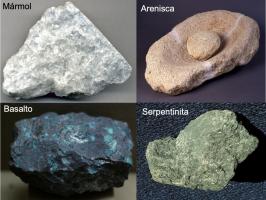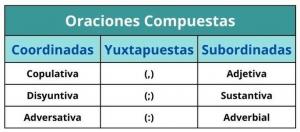The main characteristics of the eukaryotic cell
The eukaryotic cell is the type of cell that animals, plants, fungi, algae, and protozoa are made up of. It is more complex than the prokaryotic cell, which makes up bacteria and archaea.
These are the characteristics that define a eukaryotic cell:
They have a nucleus
The distinguishing feature of every eukaryotic cell is the presence of a nucleus. This is delimited by the nuclear envelope, formed by a double membrane with pores through which cellular components enter and leave.
The nucleus may have one or more nucleoli, a structure composed of ribonucleic acid (RNA) and proteins. It is here that the subunits that will serve to assemble the ribosomes outside the nucleus are produced.
Some cells may have more than one nucleus. This is the case for some liver cells. The core is usually spherical or rounded. However, there are cells whose nuclei have other shapes, such as leukocytes.
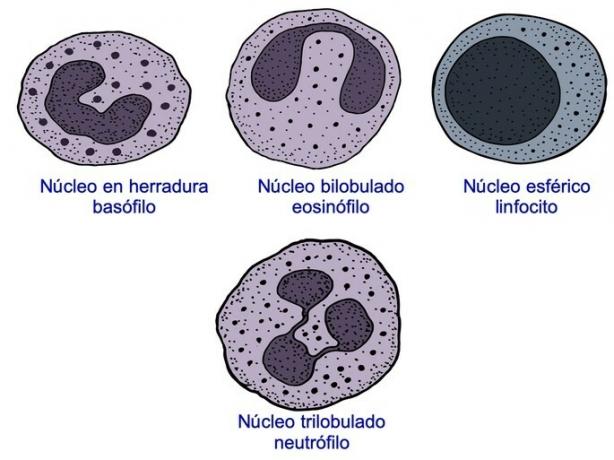
Genetic material
The genetic material of the eukaryotic cell is composed of deoxyribonucleic acid (DNA), a polymer of nucleotides forming two linked chains. It is found mainly in the nucleus. However, much smaller DNA exists in the mitochondria and in the chloroplast.
All the DNA in a cell is known as the genome. The genome of eukaryotic cells has regions that code for proteins and regions that regulate or control this coding. In addition, it has DNA protection and repair mechanisms to reduce mutations, changes in the sequence of the nucleotide chain.
Its size is measured by the number of nucleotide pairs (also called base pairs). For example, the human genome has more than 3 million base pairs, that of baker's yeast Saccharomyces cerevisiae has 12 thousand base pairs and that of the fruit fly Drosophila melanogaster 137 thousand. In human cells, mitochondrial DNA has only 16,000 nucleotide pairs.
The DNA of eukaryotic cells is packed with proteins called histones, forming chromatin.
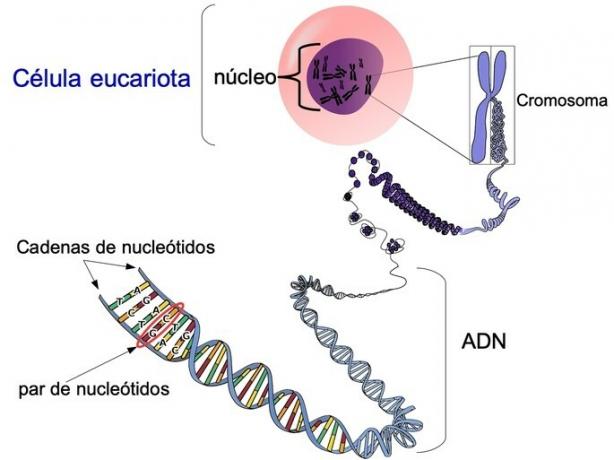
You may also be interested in seeing eukaryotic cell and prokaryotic cell.
Replication of DNA
Replication is the synthesis of DNA from a precursor DNA. For this to happen, the DNA unwinds at zones called the "origin of replication," allowing DNA-replicating enzymes to enter.
In eukaryotic cells, DNA replicates only during one phase of the cell cycle, the S phase or synthesis phase. In prokaryotic cells this process is carried out continuously. Furthermore, the genome in the prokaryotic cell has a single origin of replication, while the eukaryotic genome has several that can be active at the same time.
At the end of the S phase, the cell has twice as much DNA, which then divides in the M phase, by mitosis.
cell organization
Eukaryotic cells can live solitary or unicellular, such as paramecium and amoeba in the Protozoa kingdom and yeasts in the kingdom. fungal kingdom, or living in association with other cells, attached to each other, forming tissues, such as epithelial cells in the skin.
Multicellular organisms, such as plants and animals, are made up of a variety of eukaryotic cells, which form tissues, organs, and systems.
Form
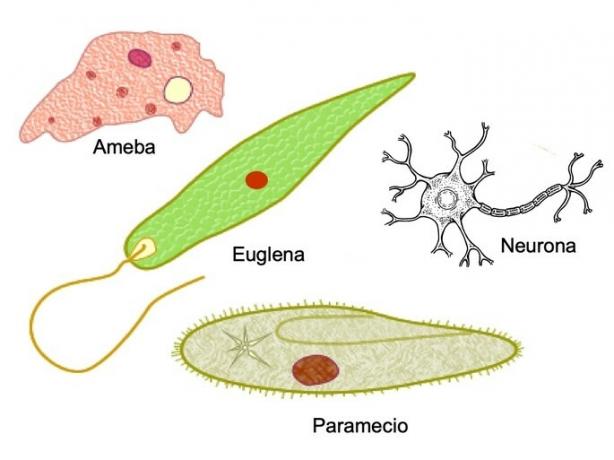
Eukaryotic cells can take on a variety of shapes. For example, amoebae do not have one shape. defined because they have the ability to crawl on surfaces, while the paramecium and the euglena are elongated.
Neurons, cells of the nervous system, have a stellate shape with extensions coming out of the cell body. These extensions are known as dendrites and axons.
Size
The size of eukaryotic cells is very varied. On average it varies between 10 and 60 micrometers (µm). For example, a yeast measures between 3 and 4 µm, the red blood cell between 5 and 10 µm while a neuron can measure up to 135 µm.
presence of organelles
Eukaryotic cells are characterized by having organelles, which are small organs with specialized functions. These organelles form compartments where the cell can separate the various functions it performs.
For example, the mitochondria concentrate the compounds and proteins that are responsible for the process of generating adenosine triphosphate ATP, the cell's energy molecule. The photosynthesis machinery is found in the chloroplast of eukaryotic plant cells.
Ribosome
Ribosomes are the protein factories of the cell. They are made up of two subunits, one large and one small, each made up of ribonucleic acid (RNA) and specific proteins.
The ribosome of the eukaryotic cell is larger than that of the prokaryotic cell, although they have the same function. However, the eukaryotic ribosome is less efficient than the prokaryotic one.
In eukaryotic cells, RNA from ribosomes is synthesized in the nucleolus and is then completed outside the nucleus.
Cellular cycle
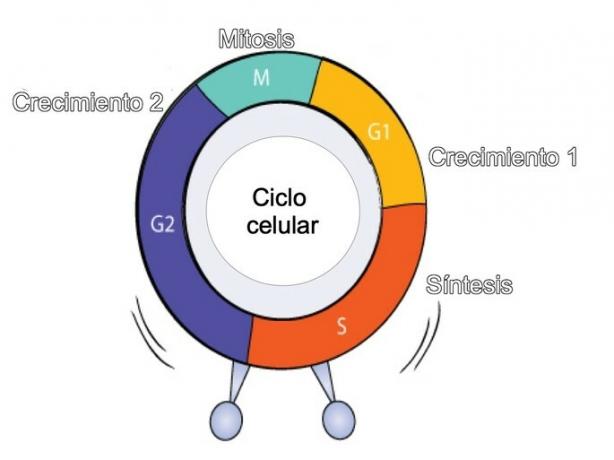
The cell cycle is the course a cell takes from the time it originates to the time it reproduces. The eukaryotic cell is characterized by having a cell cycle of four phases:
- G1 phase: first phase of growth.
- S phase: DNA is duplicated.
- G2 phase: second phase of growth.
- M phase: mitosis occurs, where the cell divides and gives rise to two new cells.
aerobic and anaerobic metabolism
Through cellular respiration, the eukaryotic cell transforms glucose into adenosine triphosphate ATP, the energy currency that allows it to carry out its different functions.
For example, yeasts in bread use fermentation to metabolize glucose, which does not require oxygen. Liver cells transform sugar in the presence of oxygen to produce ATP.
You may also be interested aerobic and anaerobic respiration
Cellular division
Eukaryotic cells can divide by mitosis to form daughter cells with the same genetic information, or by meiosis to produce cells with half the genetic material.
In the process of cell division, the DNA strands separate and go to each of the daughter cells in mitosis.
You may also be interested in seeing mitosis and meiosis.
Presence of cytoskeleton
The cytoskeleton is a structure of protein threads that intersect in the cytoplasm, forming a kind of intracellular scaffold. In this way the cell maintains its shape and can move.
The cytoskeleton is composed of microtubules, intermediate filaments, or actin filaments.
You may also be interested in seeing cell parts.
References
Alberts B, Johnson A, Lewis J, Raff M, Roberts K, Walter P. (2008) Molecular Biology of The Cell 5th ed. Garland Science. NY.
Doudna, J.A., Rath, V.L. (2002) Structure and Function of the Eukaryotic Ribosome. Cell 109: 153-156.
Geneser, F. (2005) Histology on biomolecular bases. 3ed. Pan American Medical Publishing House.

